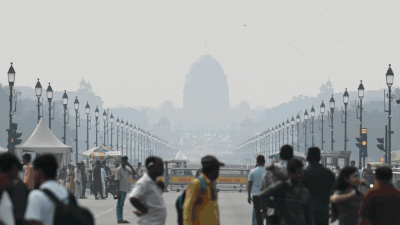
New Delhi: Delhi’s air quality takes severe hit on Tuesday air quality index (AQI) rose to 385 from 315 Monday night.
For this situation, Air Quality Management Committee (CAQM) Phase 2 has been launched Graded response action plan The National Capital Region of Delhi (GRAP II) has implemented stricter measures to mitigate pollution.
Under GRAP II, residents are advised to limit the use of private vehicles and follow guidelines regarding the operation of diesel generators. mass transportation Services will be enhanced to encourage commuters to choose cleaner modes of travel.
GRAP II limitations and recommendations
The plan takes effect at 8 a.m. on October 22, 2024, and contains a number of restrictions and recommendations:
- Increase mechanical cleaning: Routine mechanical and vacuum sweeping of identified roads will be carried out.
- Strengthen watering: Watering and dust suppression measures will be carried out every other day during off-peak hours, especially on roads with heavy traffic.
- Strict law enforcement at construction sites: Inspections of construction and demolition sites will be stepped up to ensure dust control measures are followed.
- public awareness campaign: The authorities will remind the public through newspapers and television about the current air quality levels and the necessary preventive measures that should be taken.
- Increase parking fees: Vehicle parking charges will be increased to discourage private car use and instead promote public transport.
- Power management: Measures will be taken to ensure uninterrupted power supply and no diesel generators will be used.
- Transportation enhancement: More bus and metro services will be deployed to accommodate more passengers and reduce congestion.
Public Compliance: Do’s and Don’ts
To effectively combat air pollution, citizens are encouraged to adhere to the following precautions outlined by the CAQM:
To do:
- Take public transportation and reduce the use of private cars.
- Change the air filter in your vehicle regularly.
- Avoid dust-generating construction activities between October and January.
- Report any open burning of solid waste or biomass.
What not to do:
- Do not use a diesel generator unless absolutely necessary.
- Avoid open burning of waste.
- Avoid crowded routes; use technology for better navigation.
Straw burning and poor ventilation lead to worsening air quality
Forecasts suggest Delhi’s air quality is likely to remain at “very poor” levels till Thursday due to poor ventilation, increased emissions and severe impact of stubble burning in surrounding areas. Emerging pollution hotspots such as Nehru Nagar, Sonia Vihar, Major Dhyan Chand National Stadium, ITO and Patparganj have seen higher concentrations of PM2.5, raising concerns about health risks for residents.
A recent analysis by the Center for Science and Environment showed that nine locations in Delhi now have pollution levels that are equal to or worse than 13 hotspots identified in 2018. mcg/year. Similarly, Lodhi Road (IITM station) recorded toxic pollution levels of 118 micrograms per cubic meter in 2022 and 111 micrograms in 2023.
Anumita Roychowdhury, Executive Director, CSE, emphasized the need for stringent measures across the city to prevent the emergence of new hotspots, while Sunil Dahiya of Envirocatalysts emphasized the importance of incorporating these new hotspots into city planning. pollution control agenda. Past measures such as single- and even-car schemes have failed to provide lasting relief, and systemic action throughout the year is clearly needed to address emissions at source.
Anand Vihar has become one of the most polluted areas in Delhi, with the average annual concentration of PM2.5 in 2023 being 126 micrograms per cubic meter. Established hotspot. Data shows that 9 of the original 13 hotspots recorded higher PM2.5 levels Compared with the previous year, the situation in 2023 highlights the gaps in effective action.
PM2.5 levels in Jahangirpuri reached 100 micrograms per cubic meter in 2024, 20 times higher than the World Health Organization’s safety guidelines. RK Puram, another major hotspot, has seen similar growth in pollution levels, with the annual average pollution level in 2023 being 120 micrograms per cubic meter.
While the government has taken steps to tackle the pollution problem, including inventorying pollution sources in hotspots and planning to use drones for instant monitoring, action has been slow. Experts advocate a more proactive approach, suggesting that complex sources of pollution, such as industrial activities and near landfills, must be systematically addressed to achieve substantial improvements.
Mukesh Khare, professor emeritus at IIT Delhi, stressed the need for proper classification of air quality monitoring stations, especially in densely populated areas like Anand Vihar. He pointed out that dust generated by vehicles and construction activities had a significant impact on pollution levels and stressed the need for measures such as water spraying and road vacuuming.
!(function(f, b, e, v, n, t, s) { function loadFBEvents(isFBCampaignActive) { if (!isFBCampaignActive) { return; } (function(f, b, e, v, n, t, s) { if (f.fbq) return; n = f.fbq = function() { n.callMethod ? n.callMethod(...arguments) : n.queue.push(arguments); }; if (!f._fbq) f._fbq = n; n.push = n; n.loaded = !0; n.version = '2.0'; n.queue = (); t = b.createElement(e); t.async = !0; t.defer = !0; t.src = v; s = b.getElementsByTagName(e)(0); s.parentNode.insertBefore(t, s); })(f, b, e, 'https://connect.facebook.net/en_US/fbevents.js', n, t, s); fbq('init', '593671331875494'); fbq('track', 'PageView'); };
function loadGtagEvents(isGoogleCampaignActive) { if (!isGoogleCampaignActive) { return; } var id = document.getElementById('toi-plus-google-campaign'); if (id) { return; } (function(f, b, e, v, n, t, s) { t = b.createElement(e); t.async = !0; t.defer = !0; t.src = v; t.id = 'toi-plus-google-campaign'; s = b.getElementsByTagName(e)(0); s.parentNode.insertBefore(t, s); })(f, b, e, 'https://www.googletagmanager.com/gtag/js?id=AW-877820074', n, t, s); };
function loadSurvicateJs(allowedSurvicateSections = ()){ const section = window.location.pathname.split('/')(1) const isHomePageAllowed = window.location.pathname === '/' && allowedSurvicateSections.includes('homepage')
if(allowedSurvicateSections.includes(section) || isHomePageAllowed){ (function(w) {
function setAttributes() { var prime_user_status = window.isPrime ? 'paid' : 'free' ; w._sva.setVisitorTraits({ toi_user_subscription_status : prime_user_status }); }
if (w._sva && w._sva.setVisitorTraits) { setAttributes(); } else { w.addEventListener("SurvicateReady", setAttributes); }
var s = document.createElement('script'); s.src="https://survey.survicate.com/workspaces/0be6ae9845d14a7c8ff08a7a00bd9b21/web_surveys.js"; s.async = true; var e = document.getElementsByTagName('script')(0); e.parentNode.insertBefore(s, e); })(window); }
}
window.TimesApps = window.TimesApps || {}; var TimesApps = window.TimesApps; TimesApps.toiPlusEvents = function(config) { var isConfigAvailable = "toiplus_site_settings" in f && "isFBCampaignActive" in f.toiplus_site_settings && "isGoogleCampaignActive" in f.toiplus_site_settings; var isPrimeUser = window.isPrime; var isPrimeUserLayout = window.isPrimeUserLayout; if (isConfigAvailable && !isPrimeUser) { loadGtagEvents(f.toiplus_site_settings.isGoogleCampaignActive); loadFBEvents(f.toiplus_site_settings.isFBCampaignActive); loadSurvicateJs(f.toiplus_site_settings.allowedSurvicateSections); } else { var JarvisUrl="https://jarvis.indiatimes.com/v1/feeds/toi_plus/site_settings/643526e21443833f0c454615?db_env=published"; window.getFromClient(JarvisUrl, function(config){ if (config) { const allowedSectionSuricate = (isPrimeUserLayout) ? config?.allowedSurvicatePrimeSections : config?.allowedSurvicateSections loadGtagEvents(config?.isGoogleCampaignActive); loadFBEvents(config?.isFBCampaignActive); loadSurvicateJs(allowedSectionSuricate); } }) } }; })( window, document, 'script', );







